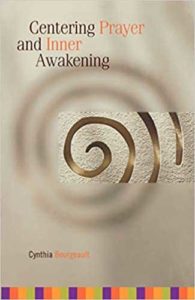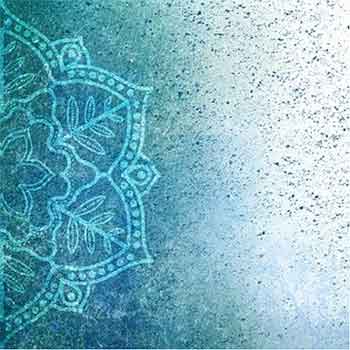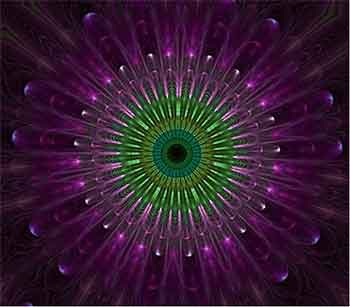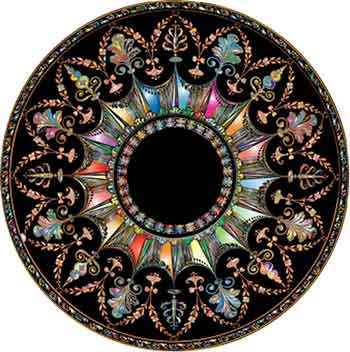See below this reflection for the Spanish translation.

This month in our Foundational Book Group Series, we’re reading Part IV of Centering Prayer and Inner Awakening, in which Cynthia takes us into “the heart” of Centering Prayer—and into our own hearts. I’ll focus this reflection on chapters 11 and 12, as the teachings she offers here have been some of the most revolutionary in my own life of practice. In chapter 11, we’re invited into a way of “paying attention” that is not anchored in the mind, but that “makes its way along a very different pathway of knowing: different, but no less effective. It is called attention of the heart” (p. 116).
Cynthia traces this teaching back to Simeon the New Theologian (949-1022), who mapped three routes by which one might “put the mind in the heart.” The first is through the concentration of affectivity (through devotional practices, visualization, etc.), the second through “self-examination and the collecting of thoughts,” and the third—which most resembles the method of Centering Prayer—through what Simeon identifies as attention of the heart, which is cultivated “by the simple release of all that one is clinging to, the good things as well as the bad things” (p. 119).
 Cynthia distinguishes this from concentrative approaches to contemplative practice, which focus on the cultivation of “clear mind” by way of concentrated mental attention, and identifies this technique instead as a surrender method, which arrives not so much at clarity of mind as purity of heart, “by way of relinquishing the passions and relaxing the will.” Through the gentle letting go of, well, everything, “one simply entrusts oneself to the deeper level, which is not really ‘unconsciousness’ at all, but rather divine consciousness resonating in the heart as ‘the hidden ground of love’” (p. 120).
Cynthia distinguishes this from concentrative approaches to contemplative practice, which focus on the cultivation of “clear mind” by way of concentrated mental attention, and identifies this technique instead as a surrender method, which arrives not so much at clarity of mind as purity of heart, “by way of relinquishing the passions and relaxing the will.” Through the gentle letting go of, well, everything, “one simply entrusts oneself to the deeper level, which is not really ‘unconsciousness’ at all, but rather divine consciousness resonating in the heart as ‘the hidden ground of love’” (p. 120).
She then asks the question (which for me has been life-changing)—“If attention of the heart really exists as a distinct energy (not just a metaphor), where is it carried in the body?” (p. 121, emphasis added). Here we enter practice as visceral, physiological, embodied—this is not the realm of mental abstraction or metaphor but resonance and felt sensation.
As Cynthia has written elsewhere, “through the constant practice of the letting go, of the surrendering of thoughts—not for any reason other than the pure gift of surrender—something develops in us, in the solar plexus area that learns this gesture. And experienced practitioners of Centering Prayer rather quickly come to the place where they feel at the center of their being this tug, this visceral tug in the heart, this honing in on the Divine Presence. And it has nothing to do with thinking about it in the mind. It’s not in the mind. It’s totally visceral.
“But something, through the process of yielding, through the actual act of surrender, develops a very clearly magnetic center. And then you have your homing beacon in you and you can follow. You can follow reliably the Divine hologram, the pattern of your life as it unfolds from the point of God…”
We discover the heart as an actual embodied center of knowing, a new seat and center of selfhood, that is increasingly “magnetized” as we place attention there, or find it simply “dropping” there through the continual surrendering of thoughts. St. Theophan the Recluse, a Russian Orthodox monk formed in this practice, writes:
“Attention [placed in the heart] gives birth to warm tenderness of heart, which in turn increases attention. They grow in strength together, supporting each other. They give depth to prayer, gradually quickening the heart: banishing distraction and wandering thoughts, they bestow on prayer its purity” (The Art of Prayer, p. 124).
Far too often, contemplative practice has become a solely “neck up” affair—awareness anchored in the head, we say our sacred word in our heads, and attempt to let go of thoughts in our heads. Here, however, we’re invited to drop out of our heads, into our hearts and bodies, where thoughts begin to slow naturally and a new magnetic center of selfhood begins to grow. Again, Theophan writes: “When attention descends into the heart, it attracts all the powers of the soul and body into one point there. This concentration of all human life in one place is immediately reflected in the heart by a special sensation that is the beginning of future warmth. This sensation, faint at the beginning, becomes gradually stronger, firmer, deeper.”
 In other words, magnetic center begins to grow. Cynthia describes the development this way: “Your emerging magnetic center is increasingly recognized as the actual inner pulsation of a mutual yearning, yours for God and God’s for you. The center begins to quicken, to take on a life of its own. Not long afterward, you may begin to sense that center calling you even when you are not officially at prayer” (p. 122). Or, in other words, it begins as a place we go to, but gradually becomes the place we come from. Cynthia calls this new center, “your interior compass, the needle of your heart pointing to the magnetic north of God” (p. 123).
In other words, magnetic center begins to grow. Cynthia describes the development this way: “Your emerging magnetic center is increasingly recognized as the actual inner pulsation of a mutual yearning, yours for God and God’s for you. The center begins to quicken, to take on a life of its own. Not long afterward, you may begin to sense that center calling you even when you are not officially at prayer” (p. 122). Or, in other words, it begins as a place we go to, but gradually becomes the place we come from. Cynthia calls this new center, “your interior compass, the needle of your heart pointing to the magnetic north of God” (p. 123).
Significantly, this center of knowing is non-identified. When identity is anchored in the heart, it becomes non-identity. We know ourselves simply as loving awareness, as pure, spacious, heart-centered presence. This doesn’t erase the other dimensions of our finite selfhood (our labels, roles, and identities in time), but it does set them against a wider backdrop, placing them in proper perspective.
In chapter 12, Cynthia connects the cultivation of the heart, or magnetic center, with the development of an “inner observer” or “witnessing presence.” This is a dimension of self that “can watch what is going on without grabbing on to the contents or claiming the process for itself” (p. 128). This inner observer “is not carried in the conscious mind being conscious of itself, but lower in your being, in magnetic center.” It’s here, from the viewing platform of the heart, that Presence or Being looks through us—and holds everything it sees in unjudging love.
This inner observer, anchored in the bridal chamber of the heart, is “there to connect the two worlds in you. It is not, as frequently assumed, a way of bailing out of your small self into your larger self, escaping the horizontal axis of your being in favor of the vertical. Rather, it lives at the intersection of the two axes, and its purpose is to bring them into meaningful alignment. … What is intended is a marriage of the two, so that the lower with its essential uniqueness and the higher with its transpersonal brilliance comes together as a true individuality” (p. 130).
We discover the heart as an intertidal zone, where the finite opens to the Infinite, and the Infinite moves into expression through the finite. As we move more deeply into the heart, we find that there is in fact no place where “I” end and “God” begins, but rather that the two wash into each other as one—each human heart a single, unique, flaring-forth of the one Heart of God.
When the heart becomes the seat of our inner observer, because of its nature as threshold or bridge, our witnessing presence can never lead to spiritual dissociation or bypassing: “Because of its primary function as connection, then, the witness is not about dissociation. It is not about ‘making a religion of one’s better moments,’ using the higher self to suppress the lower self. … It is not a matter of replacing negative emotions with positive ones—only of realizing that through magnetic center, presence can be sustained regardless of whatever inner or outer storms may assail you.”
In chapter 13, Cynthia then introduces the Welcome Prayer/Practice, which helps us carry this new center into the inner and outer storms of daily life (and which, as an awareness practice, complements the surrender practice cultivated in Centering Prayer); chapter 14 offers a meditation on “Centering Prayer and Christian Life”; and then the book concludes with a beautiful Epilogue summary titled “The Way of the Heart” (which is worth returning to again and again).
As I come back to these chapters now after several years, I’m bowled over by how deeply Cynthia’s teachings on the heart have been present all along. I have to admit that I didn’t remember these teachings being so fully developed in this book from my first reading of it a decade ago, and I imagine that’s simply because I hadn’t actually experienced very much of that to which these words pointed. When I returned to the book a few years later, having become a bit more acquainted with my own heart, I was deeply moved by these teachings. Returning to these same words again for this study, they now light up for me like the magnetic center of the book itself, heart recognizing heart. This is what it’s all about—what it’s always been all about! Thank you, Cynthia.

Matthew Wright is an Episcopal priest, writer, and retreat leader working to renew the Christian Wisdom tradition in a wider interspiritual context. He serves as priest-in-charge at St. Gregory’s Episcopal Church in Woodstock, NY and is a teacher for Northeast Wisdom and The Contemplative Society. Matthew is also a decade-long student of the Mevlevi Sufi tradition under the guidance of Shaikh Kabir and Camille Helminski. He lives with his wife Yanick, alongside the brothers of Holy Cross Monastery in West Park, NY.
All photos are courtesy of Pixabay.
Spanish Translation: Our sincere thanks to Marcela Huepe from Santiago, Chile for providing this translation.
Círculo de Lectura: La Oración Centrante y el despertar interior, IV parte
Este mes, en nuestra serie de Grupos de Lecturas Fundacionales, estamos leyendo la IV Parte de La Oración Centrante y el despertar interior, en la cual Cynthia nos invita al “corazón” de la Oración Centrante así como a nuestros propios corazones. Aquí reflexionaré sobre los capítulos 11 y 12, que ofrecen las enseñanzas que más han revolucionado mi vida de práctica. En el capítulo 11, se nos invita a “poner atención” de una manera no anclada en la mente, sino que “abriéndose paso por un camino de conocimiento muy distinto, pero no por eso menos efectivo. Se llama la atención del corazón” (p. 116).
Para Cynthia esta enseñanza se remonta a Simeón el Nuevo Teólogo (949-1022), quien trazó tres rutas mediante las cuales uno podría “poner la mente en el corazón”. La primera es a través de la concentración de la afectividad (mediante prácticas devocionales, visualización, etc.), la segunda, a través del “autoexamen y la recolección de los pensamientos”, y la tercera, que es la que más se asemeja al método de la Oración Centrante, a través de lo que Simeón identifica como una atención del corazón. Esta calidad de atención se cultiva “mediante la simple liberación de todo aquello a lo cual uno se aferra, sea bueno o malo” (p. 119).
Cynthia hace una distinción entre este acercamiento a la práctica contemplativa y otras formas, en las cuales se cultiva una “mente clara” a través de una concentración de la atención mental. Esta técnica, en cambio, se presenta como un método de renuncia, de entrega, donde, más que claridad mental, se alcanza una pureza de corazón “renunciando a las pasiones y sosegando la voluntad”. Mediante el suave dejar ir de…, bueno, todo, “uno simplemente se encomienda a sí mismo a un nivel más profundo, que no es ‘inconciencia’, sino Conciencia Divina resonando en el corazón, ‘el territorio oculto del amor’” (p. 120).
Luego, formula una pregunta (que a mí me cambió la vida): “Si la atención del corazón realmente existe como una energía perceptible (no solo como una metáfora), ¿dónde la encontramos en el cuerpo?” (p. 121, el énfasis es añadido). Y es aquí donde nos adentramos en una práctica que es visceral, encarnada, que no pertenece al ámbito de la abstracción mental o la metáfora, sino al de la resonancia y la sensación.
Como Cynthia ha escrito, “a través de la práctica constante de dejar ir, de soltar los pensamientos, sin otra motivación más que experimentar el regalo de la entrega, algo se desarrolla en nosotros, en la zona del plexo solar, que aprende este gesto. Los practicantes experimentados de la Oración Centrante pronto llegan a sentir en el centro de su ser este tirón, este llamado desde el corazón hacia la Presencia Divina. Lo que no tiene nada que ver con pensarlo con la mente. No está en la mente; es totalmente orgánico.
“A través del proceso de ceder, de un acto de entrega de sí mismo, se desarrolla un claro centro magnético. Entonces, se tiene una guía luminosa para regresar al hogar y uno puede entregarse con confianza al holograma Divino, al patrón de la propia vida desplegándose desde el interior, a partir del sitio de Dios…”
Entonces, descubrimos el corazón como un centro encarnado de conocimiento. Este nuevo asentamiento y centro para la individualidad está cada vez más “magnetizado” a medida que ponemos ahí nuestra atención, o esta aprende a “caer” allí directamente a través la constante entrega de los pensamientos.
San Teófano el Recluso, un monje ortodoxo ruso formado en esta práctica, escribe:
“La atención [puesta en el corazón] da origen a una cálida ternura del corazón, que a su vez incrementa la atención. Crecen en fuerza juntas, apoyándose mutuamente. Dan profundidad a la oración, avivando gradualmente el corazón: al desterrar la distracción y los pensamientos que divagan, confieren a la oración su pureza” (El arte de la oración, p. 124).
Con demasiada frecuencia, la práctica contemplativa se convierte en un asunto del “cuello para arriba”. Con la conciencia anclada en la cabeza, decimos nuestra palabra sagrada en nuestra cabeza e intentamos dejar ir los pensamientos de nuestra cabeza. Aquí, sin embargo, se nos invita a salir de nuestras cabezas, para ir a nuestros corazones y cuerpos, donde los pensamientos empiezan a desacelerarse naturalmente y un nuevo centro magnético de la individualidad comienza a crecer. Nuevamente, Teófano escribe: “Cuando la atención desciende al corazón, atrae todos los poderes del alma y del cuerpo hacia ese punto. Esta concentración de toda la vida humana en un solo lugar se ve inmediatamente reflejada en el corazón por una sensación especial, que es el comienzo de una futura calidez. Esta sensación, al principio débil, gradualmente se vuelve más fuerte, más firme, más profunda”.
En otras palabras, el centro magnético comienza a crecer. Cynthia describe su desarrollo de esta manera: “Voy reconociendo que este centro magnético incipiente es la pulsación interna de un anhelo mutuo, el mío por Dios y el de Dios por mí. El centro comienza a despertar y cobrar vida propia. Poco después, se puede sentir cómo este centro me llama incluso cuando no estoy en oración”(p. 122). O, en otras palabras, comienza siendo un lugar hacia el cual nos dirigimos, pero gradualmente se convierte en el sitio del cual venimos. Cynthia llama a este nuevo centro, “la brújula interior, la aguja magnética del corazón apuntando al norte de Dios” (p. 123).
Es revelador que este centro de conocimiento no se encuentre asociado a roles o etiquetas. Cuando la identidad está anclada en el corazón, se convierte en una no-identidad. Nos reconocemos naturalmente como conciencia amorosa, presencia pura, vasta, abierta y centrada en el corazón. Esto no descarta las otras dimensiones de nuestra individualidad finita, identidades ancladas a un tiempo específico, sino que las sitúa en un contexto más amplio, poniéndolas en perspectiva.
En el capítulo 12, Cynthia conecta el refinamiento del corazón, o centro magnético, con el desarrollo de un “observador interno”, de una presencia que solo atestigua. Esta es la dimensión del ser que “puede observar lo que sucede sin aferrarse a los contenidos ni apoderarse del proceso mismo de observar” (p. 128). Este observador interno “no está en la mente consciente haciéndose consciente de sí misma, sino que habita más abajo, en el centro magnético”. Es aquí, desde el lugar de observación del corazón, donde la Presencia o el Ser mira a través de nosotros y sostiene todo lo que ve en un amor que no juzga.
Este observador interior, anclado en la cámara nupcial del corazón, está ahí “para conectar los dos mundos que hay en nosotros. No es, como frecuentemente se asume, una manera de liberarse del yo pequeño para instalarse en el yo más grande, retirándose del eje horizontal para instalarse en el eje vertical del ser. Más bien, el observador habita en la intersección de ambos ejes buscando que se alineen… El propósito es la unión entre los dos, de modo que la singularidad esencial de lo bajo y el brillo transpersonal de lo alto emerjan como verdadera individualidad” (p. 130).
Descubrimos que el corazón es como una zona intermareal, donde lo finito se abre al Infinito y lo Infinito busca expresarse a través de lo finito. Al adentrarnos más profundamente en el corazón, descubrimos que, de hecho, no hay un lugar donde “yo” termina y “Dios” comienza, sino que los dos se mezclan en uno, y cada corazón humano es una expresión única del Corazón de Dios.
Cuando el corazón se convierte en el lugar de nuestro observador interno, dada su naturaleza de umbral o puente, nuestra presencia que atestigua nunca puede conducir a la disociación o al bypass espiritual: “Debido a que la función principal de estar presentes es la conexión, no es posible disociarse. No hay cómo empezar a ‘hacer una religión de nuestros mejores momentos’, utilizando el yo superior para reprimir al yo inferior… Porque no se trata de reemplazar las emociones negativas por positivas sino de reconocer que, a través del centro magnético, una presencia puede ser sostenida sin importar las tormentas internas o externas que puedan remecernos”.
En el capítulo 13, Cynthia introduce la Oración/Práctica de Bienvenida, que nos ayuda a ir con este nuevo centro hacia las tormentas internas y externas de la vida diaria (y que, siendo una práctica para el desarrollo de la atención, complementa la práctica de la entrega que se cultiva a través de la Oración Centrante); el capítulo 14 reflexiona sobre “La Oración Centrate y la vida cristiana”. Finalmente, el libro concluye con un hermoso epílogo resumen titulado El camino del corazón (al que vale la pena regresar una y otra vez).
Al volver a estos capítulos luego de varios años, me sorprende cuán profundas las enseñanzas de Cynthia sobre el corazón han estado siempre presentes. Admito que, de mi primera lectura de este libro hace una década, no recordaba que estuvieran tan desarrolladas. Puedo suponer que esto ocurrió porque no había experimentado mucho lo que este texto señalaba. Cuando volví al libro unos años más tarde, después de haberme familiarizado un poco más con mi propio corazón, estas enseñanzas me conmovieron profundamente. Volviendo sobre las mismas palabras, ahora estas se iluminan como el centro magnético del libro; corazón reconociendo a corazón. De eso se trata ¡y se ha tratado siempre! Gracias, Cynthia.
*****
Nota: La paginación corresponde a: Bourgeault, Cynthia. Centering Prayer and Inner Awakening. Cambridge, Massachusetts: Cowley Publications, 2004.
Centering Prayer and Inner Awakening Book Circle
A monthly series of posts from the friends and leaders of the Northeast Wisdom/Wisdom Waypoints Book Circle Series on: Centering Prayer and Inner Awakening by Cynthia Bourgeault.

I had text which describes St. Theophan’s instructions to, upon awakening as soon as you become aware of yourself to descend to the heart and gather all your forces there. I cannot locate the text. Can you refer me to this text in some source.
I have a copy of ‘thoughts for each day of the year’ and ‘preaching another Christ’
Id appreciate your suggestion.